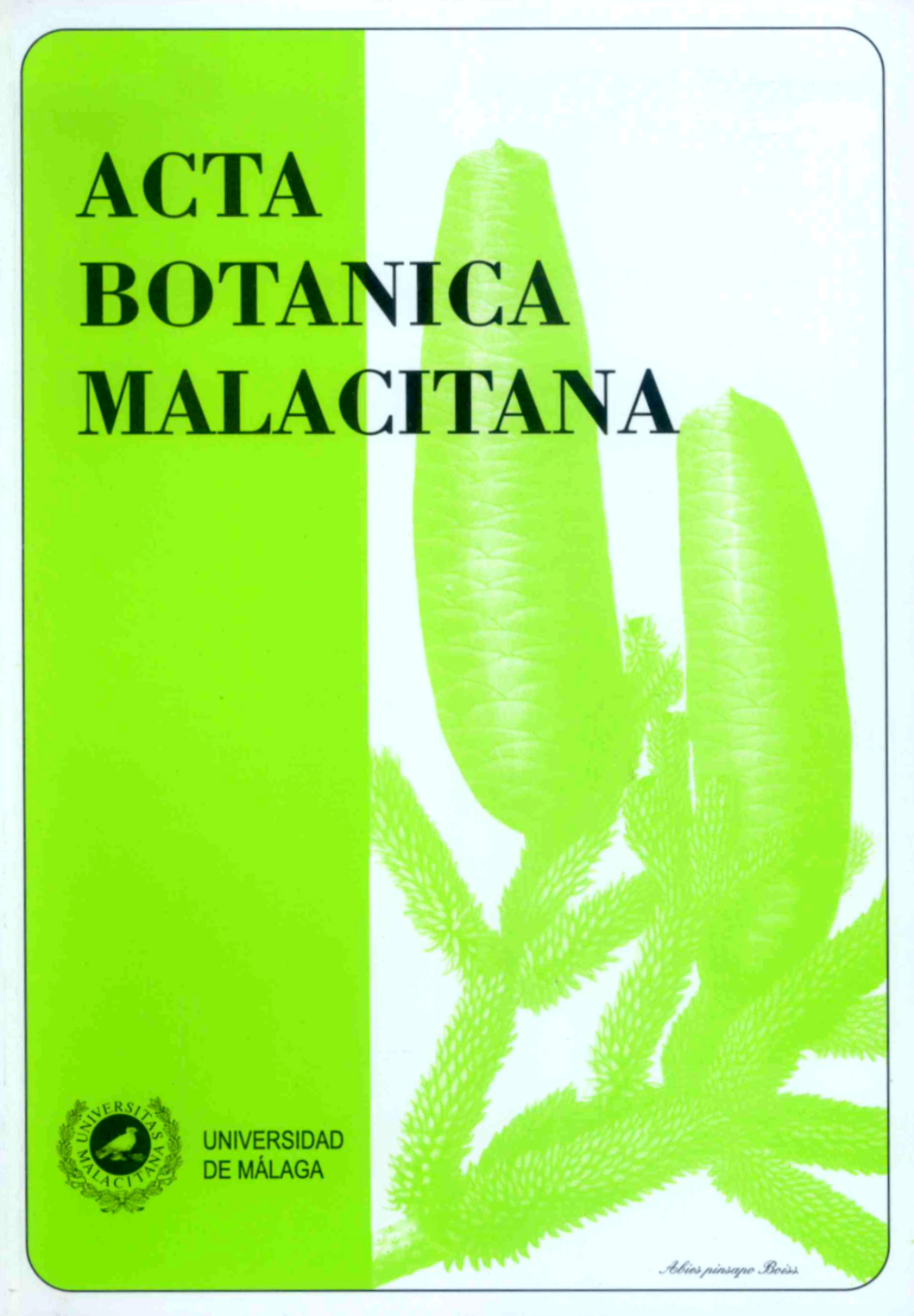Vegetacio?n del Parque Natural de las Sierras Tejeda, Almijara y Alhama (Ma?laga- Granada, Andaluci?a, Espan?a).
DOI:
https://doi.org/10.24310/abm.v29i0.7228Abstract
RESUMEN. Vegetación del Parque Natural de las Sierras Tejeda, Almijara y Alhama (Málaga- Granada, Andalucía, España). Se ha realizado un estudio florístico, fitocenológico y fitogeográfico del territorio comprendido en el Parque Natural. Bioclimáticamente aparecen los pisos termo, meso (el más extenso), supra y oromediterráneo con ombrotipos seco, subhúmedo y húmedo. Se propone una sectorización fitogeográfica a un nivel inferior al de sector, con cinco unidades: unidad Tejedense (Sierra Tejeda) la más occidental y diversa, unidad Jayenense (área de Jayena) con influencias ibérico- orientales, Almijarense (Sierra Almijara) la más representativa, Nerjeña (Sierra de Nerja) con influencia alpujarreña, y Cazulense (Sierra de Cázulas) la más oriental. El territorio presenta una gran diversidad de asociaciones y comunidades (126), algunas de ellas novedades sintaxonómicas, destacando Genistetalia haenseleri-ramosissimae ordo novus. Se han catalogado 23 series de vegetación. 9 de tipo climatófilo, caracterizadas por planifolios (Quercus rotundifolia, Q.suber, Q. pyrenaica y Acer granatensis), por gimnospermas (Juniperus communis subsp. hemisphaerica, J. sabina) o por arbustos sabanoides relictos (Maytenus senegalensis). 7 edafohidrófilas (caracterizadas respectivamente por Salix pedicellata, Salix eleagnos, Salix atrocinerea, Salix alba y Nerium oleander). Existe un complejo edafogénico de vegetación hidrófila (Erica erigena, E. terminalis, Schoenus nigricans). La vegetación permanente y edafoxerófila corresponde a 3 comunidades (caracterizadas por Buxus balearica, Pinus halepensis, Juniperus phoenicea o Pistacia lentiscus) y 3 series (de B. balearica, y de J. phoenicea con Pinus pinaster o con P. nigra subsp. salzmanii). Se aportan el esquema sintaxonómico, los inventarios y/o tablas fitosociológicas de novedades, un cuadro de series y un mapa fitogeográfico.
Palabras clave. Vegetación, fitosociología, fitogeografía, Sierra Tejeda, Sierra Almijara, Málaga, Granada, Andalucía, España.
SUMMARY. Vegetation of the Natural Park "Sierras de Tejeda, Almijara y Alhama" (Malaga- Granada, Spain). The Natural Park is located in the south of Andalusia, nearby Mediterranean Sea, between Malaga and Granada provinces and comprises several dolomitic mountain ranges. Bioclimatic belts termo, meso (the widest), supra and oromediterraean have been found. Dry, subhumid and humid ombrotypes change respectively towards the summit of the ranges. A phytogeographical scheme is proposed to a lower level of subsector: Tejedense unit (Sierra Tejeda) the western most and diverse, Jayenense unit (Jayena area) shows strong eastern-iberian relationships, Almijarense unit (Sierra Almijara) the most representative, Nerjeña unit (Sierra de Nerja) shows relationships to Alpujarreño subsector, Cazulense unit (Sierra de Cázulas) is the eastern most. Regarding vegetation, the Park shows a great diversity of associations and communities (126), some of them considered as new syntaxa, emphasizing Genistetalia haenseleri-ramosissimae ordo novus. 23 vegetation series have been found: 9 climatic series, 7 characterised by broad-leaved trees (Quercus rotundifolia, Q.suber, Q. pyrenaica and Acer granatensis), 1 by gymnosperms (Juniperus communis subsp. hemisphaerica, J. sabina) and 1 by relict savanna-like shrubs (Maytenus senegalensis); 7 series are edaphic river- linked series (characterised respectively by Salix pedicellata, Salix eleagnos, Salix atrocinerea, Salix alba and Nerium oleander). We have also found mosaics complexes of hydrophilic vegetation (Erica erigena, E. terminalis, Schoenus nigricans). Soil-xeric permanent vegetation corresponds to 3 communities (characterised by Buxus balearica, Pinus halepensis, Juniperus phoenicea or Pistacia lentiscus) and 3 series (one dominated by B. balearica, and two for J. phoenicea with Pinus pinaster or P. nigra subsp. salzmanii). A syntaxonomical scheme, typus relevés, phytosociological tables, series and zono-potential tables and a phytogeographical map are also included.
Key words. vegetation, phytosociology, phytogeography, Sierra Tejeda, Sierra Almijara, Malaga, Granada, Andalusia, Spain.
Downloads
Metrics
Downloads
Published
How to Cite
Issue
Section
License
All information related to the licensing of published works in Acta Botanica Malacitana and copyright can be found in our Editorial Policy.







1.png)
